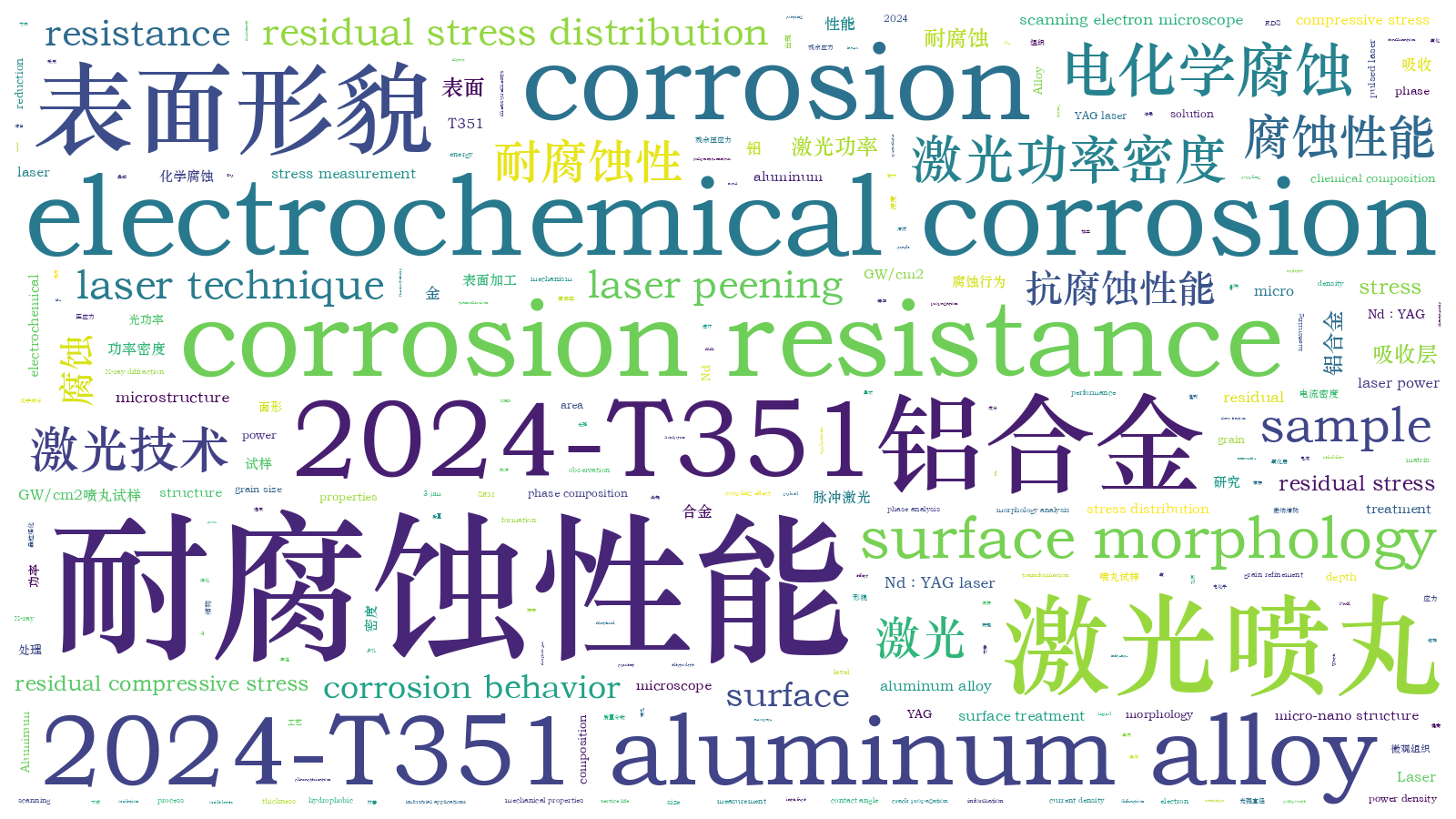无吸收层激光喷丸2024‑T351铝合金耐腐蚀性能研究【增强内容出版】
The 2024-T351 aluminum alloy, which belongs to the Al-Cu-Mg series and is extensively used in the aerospace industry, exhibits inadequate corrosion resistance that affects its reliability and service life. Laser peening (LP) has emerged as a novel surface treatment technology capable of enhancing both mechanical properties and corrosion resistance of 2024-T351 aluminum alloy. However, conventional LP requires an additional energy protective layer, limiting its practical industrial applications. LP without coating (LPwC) offers a promising alternative to conventional LP. The present study focuses on investigating the 2024-T351 aluminum alloy and employs a Nd∶YAG laser to perform LPwC treatment on the sample surfaces. By utilizing the experimental characterization techniques including surface morphology analysis, chemical composition examination, microstructure observation, phase analysis, and residual stress measurement, a comparative analysis of the corrosion behavior is conducted on the LPwC samples with laser power densities of 1.1 GW/cm2 and 2.6 GW/cm2 in the NaCl solution with mass fraction of 3.5%. The corrosion resistance mechanism of the LPwC process is also elucidated.
The experimental samples processed by the Nd∶YAG pulsed laser were selected from 10 mm×10 mm×2 mm square specimens. First, the surface and cross-sectional morphologies of the samples were observed using a scanning electron microscope (SEM). Second, the element compositions of the selected areas were analyzed by the energy dispersive spectrometer (EDS) attached to the scanning electron microscope. Third, the wetting performance of the samples was determined using a angular contact measuring instrument. Subsequently, the microstructure of the samples was examined with the SEM, and the X-ray diffraction (XRD) analysis provided information on the phase compositions of their surfaces. Furthermore, the X-ray stress tester allowed for measuring the residual stress distribution along the depth direction in these samples. Finally, electrochemical corrosion experiments were conducted on the electrochemical workstation to characterize corrosion resistance properties of these samples after immersing them in an electrolyte solution for 30 min.
Surface morphology observation revealed that after the LPwC treatment, the samples exhibited a multi-level structure with staggered micro-nano bumps and holes (Fig.3). Water contact angle measurements demonstrated the hydrophobic properties of the LPwC-treated samples, with 131° for the L-1 sample and 112° for the L-2 sample, effectively reducing the contact area in corrosive solutions (Fig.4). EDS analysis confirmed the formation of a remelted oxide layer with a thickness of 2?3 μm on the surfaces of the L-1 and L-2 samples (Fig.5). Grain size statistics indicated a 25% reduction in average grain size for the L-1 sample and a 37.5% reduction for the L-2 sample (Fig.6). Residual stress measurement showed maximum residual compressive stress at a depth of 100 μm for both L-1 and L-2 samples, with amplitudes of -100 MPa and -115 MPa, respectively (Fig.8). Furthermore, electrochemical corrosion experiments revealed corrosion inhibition efficiencies of 97.30% for the L-1 sample and 84.63% for the L-2 sample, highlighting significantly improved corrosion resistance (Fig. 9).
The influence of surface morphology, chemical composition, microstructure, phase composition, and residual stress on the LPwC-treated samples with different laser power densities was discussed in this study. The electrochemical corrosion behavior was analyzed and the corrosion resistance mechanism of the LPwC process was summarized. The main conclusions were as follows: 1) The thermodynamic coupling effect induced by LPwC resulted in the formation of a micro-nanoscale bumps and holes staggered multi-level structure and a 2?3 μm thickness dense remelted oxidation layer on the sample surface. This reduced the actual contact area between the matrix and the corrosion solution, improved the chemical activity of the surface material, and enhanced corrosion resistance in corrosive environments. 2) LPwC treatment led to grain refinement and residual compressive stress effects on the surface layers of aluminum alloy samples. The grain sizes of LPwC-treated samples at 1.1 GW/cm2 and 2.6 GW/cm2 were reduced by 25% and 37.5%, respectively. And the maximum residual compressive stresses of -100 MPa and -115 MPa were formed at a depth of 100 μm. This enabled tensile-compressive transformation within the matrix, inhibiting corrosive ion transmission and corrosion crack propagation within samples while significantly delaying overall corrosion. 3) Laser power density has a significant impact on the corrosion resistance of LPwC-treated samples. Under the 1.1 GW/cm2 condition, a micro-nano multilevel structure formed on sample surface exhibited a superior hydrophobic characteristic, with a water contact angle reaching 131°, 17.0% higher than that for the LPwC-treated sample at 2.6 GW/cm2. The composite interface created by this multilevel micro-nano structure along with an air micro-cushion layer effectively reduced solid-liquid contact area, resulting in an 82.46% reduction in the corrosion current density of the sample, demonstrating an exceptional corrosion resistance performance.
夏雪峰, 周建忠, 缑延强, 黄蕾, 孟宪凯, 黄舒. 无吸收层激光喷丸2024‑T351铝合金耐腐蚀性能研究[J]. 中国激光, 2024, 51(12): 1202204. Xuefeng Xia, Jianzhong Zhou, Yanqiang Gou, Lei Huang, Xiankai Meng, Shu Huang. Corrosion Resistance of 2024‑T351 Aluminum Alloy Processed by Laser Peening Without Coating[J]. Chinese Journal of Lasers, 2024, 51(12): 1202204.






